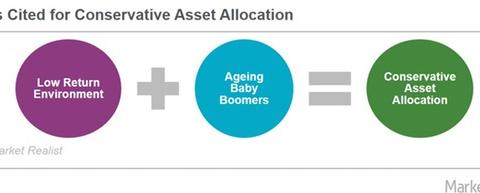Demographics Driving Conservative Investment? Bernstein Says No
After stating that the market isn’t in a low return environment, Richard Bernstein moved on to discuss the reasons cited by many for conservative asset allocation.
Nov. 16 2016, Published 3:37 p.m. ET

Changing demographics
After stating that, contrary to several investors’ beliefs, the market isn’t in a low return environment, Richard Bernstein moved on to discuss the reasons cited by many for conservative asset allocation.
Bernstein stated that according to some, conservative investments are on the rise due to changing demographics. These observers are of the opinion that the Baby Boomer generation, born after World War II and currently aged over 50, is aging. This has led to investors from that generation to desire safer, income-generating investments. In turn, this has led a change in asset allocation and a dash toward safety.
Bernstein disagrees
Though Baby Boomers are aging, Bernstein disagrees with the argument that age is causing the conservatism in asset allocation. He holds that “their preference for fixed-income and income-oriented equity seems to be more a function of fear than of demographics.”
He contends that Baby Boomers have become risk averse and feel that investing in fixed-income equity is safe. The stock market crash of 2008 is still fresh in their memories. Income-generating strategies outperformed others during that time for two reasons:
- low betas embedded in dividend strategies
- negative correlation between Treasuries and stocks
Due to this experience and Baby Boomers’ fears regarding equities, they’ve shifted their focus toward income-generating strategies.
Capital appreciation versus income generation
In his earlier newsletters, Bernstein noted that the investor sentiment at the height of the dot-com boom about 15 years ago was that of a permanent change in the form of the “new economy.” The term referred to the economy’s transition from a manufacturing-based economy to a services-based one. Dividends were considered toxic, with dividend-paying companies disappointing investors who thought they didn’t know what to do with their excess money.
However, at present, things are almost the opposite of what they were 15 years ago. Capital appreciation has taken a backseat to income. Investors want income in any form: dividends (PFF) (PGX) (DVY) or fixed-income products. Johnson & Johnson (JNJ), United Parcel Service (UPS), and 3M Company (MMM) are examples of good dividend-paying stocks.
The reason Bernstein thinks it’s important to draw comparisons to the dot-com bubble is because of his belief that investors expect the catastrophic events of 2008 to be lurking around the corner. He maintains that it’s this fear, not demographics, that’s responsible for the interest in conservative asset allocation strategies.
In the next article, we’ll discuss Bernstein’s conclusion that chasing safe strategies may not actually be safe.
